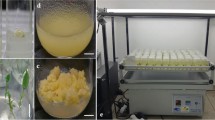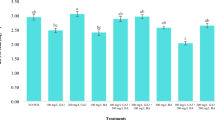Abstract
IN at least two reports the method of sterilization for medium to be used for tissue culture experiments was autoclaving1,2. The question of the heat stability of gibberellin is raised. It is generally thought that gibberellin is stable on the basic side of neutrality and at room temperature at neutral or near neutral pH, and more labile at elevated temperatures at extreme pH values. It has been stated that even weakly acid media will destroy gibberellin and that it is much more stable in neutral and basic solutions (Stowe, B. B., private communication, November 7, 1958).
This is a preview of subscription content, access via your institution
Access options
Subscribe to this journal
Receive 51 print issues and online access
$199.00 per year
only $3.90 per issue
Buy this article
- Purchase on Springer Link
- Instant access to full article PDF
Prices may be subject to local taxes which are calculated during checkout
Similar content being viewed by others
References
Schroeder, C. A., and Spector, C., Science, 126, 701 (1957).
Henderson, James H. M., Nature, 182, 880 (1958).
Koch, F. G., and Hanke, M. E., “Practical Methods in Biochemistry”, 99 (Williams and Williams, 1943).
Phinney, Bernard O., Proc. U.S. Nat. Acad. Sci., 42, 185 (1956).
Author information
Authors and Affiliations
Rights and permissions
About this article
Cite this article
HENDERSON, J. Influence of Hydrogen Ion Concentration and Autoclaving on Gibberellin. Nature 185, 628–629 (1960). https://doi.org/10.1038/185628a0
Issue Date:
DOI: https://doi.org/10.1038/185628a0
This article is cited by
-
Enhancement of somatic embryogenesis frequency by gibberellic acid in fennel
Plant Cell, Tissue and Organ Culture (1995)
-
A Possible Mechanism for Biological and Chemical Activity of Gibberellic Acid
Nature (1962)
-
Decomposition of gibberellic acid in aqueous solutions
Folia Microbiologica (1962)
Comments
By submitting a comment you agree to abide by our Terms and Community Guidelines. If you find something abusive or that does not comply with our terms or guidelines please flag it as inappropriate.



